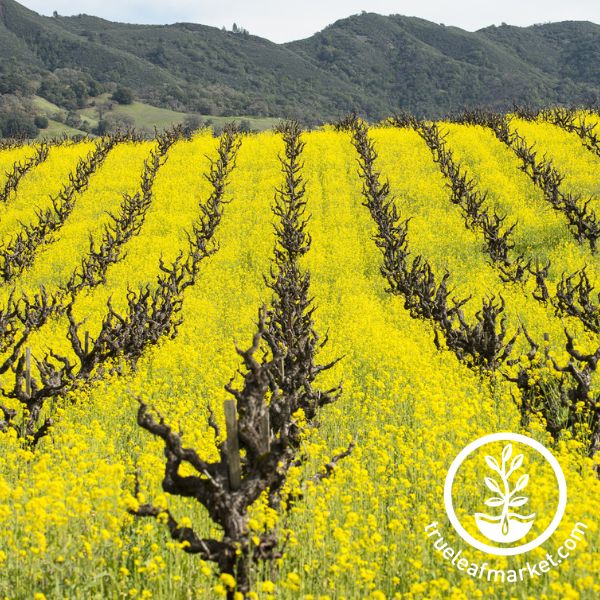Cover crops and green manures are plants grown because of their soil restoration properties to combat detrimental soil erosion, suppress weeds, and restore depleted soils. These plants can help deposit important nutrients into the soil to be used by other plants when they are grown, cut, and left to decompose into the soil. Cutting or mowing these plants before they go to seed allows their biomass (plant matter) to become soil again with a greater nutrient density. Terminating cover crops at the right time will prevent them from becoming weeds for the coming growing season. In fact, they can help prevent weeds from becoming established.
Types of Cover Crops
Legumes
Some of the most notable cover crops include plants of the legume family. These have nitrogen-fixing nodules in their root systems. The nodules host bacteria that convert nitrogen in the air into a form usable by plants in the soil. Common legume cover crops include peas, lentils, cowpeas, clover, beans, and vetch.
Grains
Grains can be used to produce organic matter that improves soil structure. Organic matter is the portion of soil that is made of living and decomposed matter. This is extremely important as it contributes the the moisture retentive and nutrient holding properties of your soil. It can also help the soil to be more workable and better support root development. Common grain cover crops include oats, rye, wheat, buckwheat, triticale, barley, and spelt.
Brassicas
Mustards and radishes are great at deterring pests and suppressing weeds. As they grow, they release natural chemicals throughout the soil that reduce pest problems for your main garden crops. Radishes are also good for reducing soil compaction. Heavy clay soils make it difficult for roots to develop. When grown as a cover crop radishes help aerate the soil for the coming season. Other broadleaf species can also help attract pollinators to your other crops.
An Organic Solution to Overworked Land
Once fertilizers were manufactured and easily distributed cover crops began to decrease in popularity. This is because you could decide how much of each nutrient type was added to your field on demand, thus gaining more control of your crop growth. With time, using pesticides has also become more popular to prevent any plant other than your crop from growing. While these practices have contributed to many advances in agriculture, they have also led to weaker soils across the globe. There is more to your soil than just proving nutrients to your crops.
By utilizing cover crops you can reduce the amount of fertilizer needed for your growing season. In addition to reducing fertilizer applications, cover crops can increase the organic matter content of your soils and reduce the amount of pesticides needed on your fields. This means better drainage, water retention, moisture, natural pest control, and more for your money-making and life-sustaining crops. Using cover crops allows the plant components to decompose creating better soil to support your crop growth with organic pest control.
The best part of using cover crops is the long-term benefits to your soil structure. Increased organic matter means your soils retain more moisture, have better drainage, and erode at slower rates compared to the overworked soils existing across the world. If all we do is grow, grow, and grow without replenishing the basic components used to build plant material, we will deplete most of our arable land.
Cover crops are a key action that can help us return our soils to their healthiest and most productive states. For easy-to-access information take a look at our Download Free Cover Crop Growing Guide PDF. If you are a large-scale farmer, you may not see the great benefits of your cover crop efforts immediately. It can take years to fully restore soils, but the future generations farming your land will thank you immensely for putting in the work to preserve the land. Using cover crops in addition to limited or no-till methods can allow you to see faster results in your soils.
How To Grow Cover Crops:
1. Identify the needs of your soil. Is it too compact with clay? Too light and dry? Have issues controlling weeds or pests?
2. Match your needs with the right cover crop seeds. Don't know which seeds you need? Either use an all purpose garden cover crop mix to get started, or puruse our cover crop guide to select your seed types.
The summer season is the best time to purchase cover crop seeds.
3. Prepare When you are ready to plant your seeds, apply an inoculant to any legume seeds (Pea, vetch, bean, lentils, soybeans, alfalfa, and clover). Inoculants are treatments that give your seeds a boost of access to important bacteria responsible for processing nitrogen from the air into usable forms for the plants. Because soils have become sparse with these important soil bacterium, an inoculant gives your soil a head start as your seeds begin to sprout. Using the chart in our Free Downloadable Cover Crop Growing Guide PDF mix the correct amount of inoculant, water, and seeds together. Plant within 12 hours before your inoculant wears off.
4. Plant Spread your cover crop seed using the broadcasting method and the recommended coverage rates.
- Spring - Plant in the early spring and allow to grow until a few weeks before you plan to plant your crops. Mow your cover crop down.
- Fall - Plant when summer temperatures are waning so your cover crop seeds can germinate and get enough growth during fall weather. Around the first frost or plant maturity mow down and allow to decompose over the winter.
- If you have questions regarding your first and last frost dates contact your local agricultural extension office for information about your local climate factors.
5. Terminate. It is important to kill the cover crop by mowing, cutting, or tilling the crop into the soil. It is best to do this before flowering starts. Cover crops are only meant to grow for a short time before being worked back into the soil. They are not meant to be grown among your regular crops during the growing season. Instead grow them in the fall following a summer harvest, or early spring before a later planting. Allow at least 2-3 weeks after terminating your cover crop before planting anything. If you do not wait this period before planting, necessary nutrients for the new plants may be "tied up" or robbed due to early stages of the decomposition process.



















3 comments
I live in ne ga and want to use the clover trio cover as a ground cover for my back yard. Want to invite pollinators to set up camp to help our small garden and local vegetation. Do you think this will work?
Jim,
Growing anything during the hot summer months can be hard. The good thing about growing a cover crop during this time though is that you can actually prevent long-term issues like erosion, improve soil structure, and increase soil nutrients. Yes, you will need to water your cover crops during these months, however, you don’t have to feel the same devastation if these crops dry up earlier than desired. They can also be less demanding of water than other fruiting crops. The purpose of cover crops is to prevent erosion while preserving and increasing soil fertility, not to harvest a pretty crop. I would recommend planting a crop of buckwheat or sorghum, mowing it down before it goes to seed, and letting the summer heat aid decomposition. These crops are ready relatively quickly with some water. To reduce water loss apply water in the late evening and/or early morning hours. While some microbes will diminish in population during the high heat, others will flourish. You will also see more decomposition during the fall season as temperatures cool a bit. You also have the option of planting a cover crop during the fall for a boost in nutrients in time for the coming spring season with less heat stress throughout the process. Just having something over that soil throughout the summer is better than nothing. During the high summer heat exposed soils become more susceptible to wind erosion as the soil particles become lighter without moisture or root systems to hold them down.
-Ashleigh
Ashleigh,
My garden is divided into 3 parts. I leave one part fallow every third year and add mulch. I would like to plant a cover crop in the fallow part. However, we live in central California, where it doesn’t rain from about April to November. My understanding is that a cover crop would need to be watered in order to flourish, and I am reluctant to heavily water the fallow section of our garden because of the amount of water that we would be using during the dry season, especially now that we are in a prolonged “drought” period and we are being asked to seriously cut back on our water consumption. Do you have any suggestions?
I assume that the soil microbes are inactive during the dry period also, so this would prevent the mulch from being integrated in the soil.
~ Jim